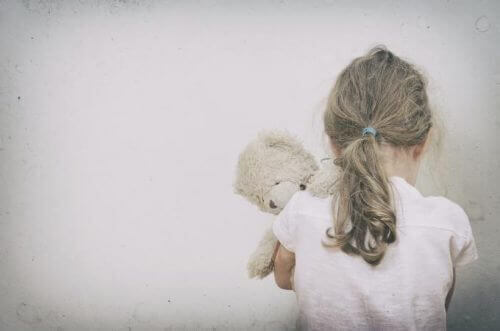Childhood Attachment and its Importance in Adult Life

Childhood attachment is the emotional and behavioral bond that’s established in the early stages of human life, which can have an effect on future relationships.
In all things, however, there must be a balance, and this is no exception. Too much attachment, too much pampering, or too much protection can be just as harmful as the absence of hugs, affection, or attention.
Childhood attachment is a basic need

Childhood attachment allows a child’s brain to develop in a natural and healthy way. Attachment starts to establish certain dynamics related to relationships and socializing with others.
If parents don’t think about their children or pull away from them – creating a dysfunctional relationship – their children will be less likely to be secure in their future relationships.
Safety and security in the first years of life are very important to be able to build healthy relationships and not wind up with emotional dependency. So, it’s something to be cared for.
Discover: Teach Your Children to Dream, not Fear
When children suffer from separation from their parents in the early period of attachment, for example, they may focus on that.
In most cases, parents may ignore their children because they believe that they’re not aware of anything. Many mistakenly believe that little kids can’t develop anxiety issues related to their personal interactions.
Types of childhood attachment
1. Secure attachment

In this type of attachment, parents approach their children and respond to their emotional needs. They don’t ignore them, they show them affection, and they always seek contact.
Seeking contact doesn’t only mean giving kisses or hugs, it can be much more. And sometimes, small children don’t respond to such gestures because they don’t want them.
2. Anxious or ambivalent attachment
In this type of attachment, the parents are affectionate but they don’t know how to demonstrate it. There is less contact as a result and they don’t empathize with their children. Thus, and there is some distance.
In addition, something important to remember is that in this type of attachment, there is always a negative attitude toward the child. The parents often point out all the bad things they do, but not the good ones.
This can lead to a lack of self-esteem.
Read: When Self-Pity Traps You
3. Anxious and avoidant attachment

In this case, there’s a clear rejection of the child and parents can exhibit very unpleasant behaviors.
Parents who are unfaithful, alcoholic, abusive, or view the child as invisible or a burden, are examples of this situation.
Rejection is common, as is punishment. The child will understand that they are a nuisance and unloved. This will be reflected in their relationships later in life, in which they will always be disappointed.
4. Anxious and disorganized attachment

This final example of childhood attachment involves abuse and manipulation within the family, especially between the parents.
The child becomes disoriented because they approach their paternal figures who cling to them, but then manipulate them. This develops into a relationship based on fear and misunderstanding.
This manifests in later relationships when they don’t know what they want. They will not learn how to love, and manipulation and control will always be present.
In conclusion
As you’ve seen, childhood attachment is very important and the root of many problems that manifest in relationships in our adult lives.
It’s essential to develop healthy attachments because your parents are with whom you form your first social bonds with.
Balance, as we said above, also plays a key role. Both the excess and lack of contact and affection can be very negative.
The most significant consequence is to cause them to depend on others, not only to seek affection, but also to seek approval.
Above all, not all of us experienced secure attachment in childhood but the good thing about all of this is that it can be changed.
Finally, you can learn how to improve upon those frustrating and painful relationships that are the product of a childhood and affected your development.
All cited sources were thoroughly reviewed by our team to ensure their quality, reliability, currency, and validity. The bibliography of this article was considered reliable and of academic or scientific accuracy.
- Bowlby, J. (1979). The Bowlby-Ainsworth attachment theory. Behavioral and Brain Sciences, 2(4), 637-638. https://www.cambridge.org/core/journals/behavioral-and-brain-sciences/article/abs/bowlbyainsworth-attachment-theory/6D35C7A344107195D97FD7ADAE06C807
- Páez, D., Fernández, I., Campos, M., Zubieta, E., & Casullo, M. (2006). Apego seguro, vínculos parentales, clima familiar e inteligencia emocional: socialización, regulación y bienestar. Ansiedad y estrés, 12(2-3), 329-341. https://www.researchgate.net/publication/301650510_Apego_seguro_vinculos_parentales_clima_familiar_e_inteligencia_emocional_socializacion_regulacion_y_bienestar
- Pérez, V. R., & Martínez, L. M. R. (2015). Apego, miedo, estrategias de afrontamiento y relaciones intrafamiliares en niños. Psicología y salud, 25(1), 91-101. https://psicologiaysalud.uv.mx/index.php/psicysalud/article/view/1342/2468
- Amar Amar, J., & Berdugo de Gómez, M. (2011). Vínculos de apego en niños víctimas de la violencia intrafamiliar. Psicología desde el Caribe, 1-22. http://rcientificas.uninorte.edu.co/index.php/psicologia/article/viewFile/2076/9353
This text is provided for informational purposes only and does not replace consultation with a professional. If in doubt, consult your specialist.








